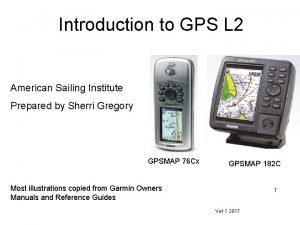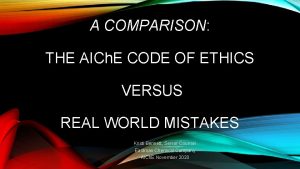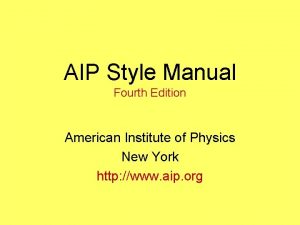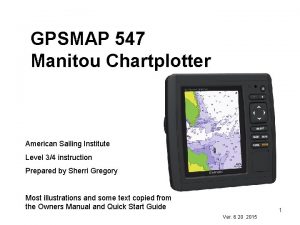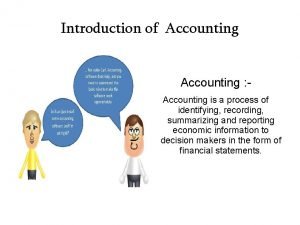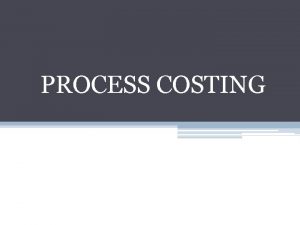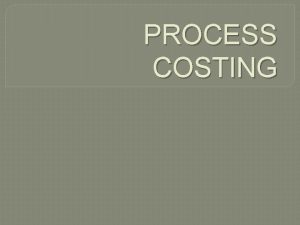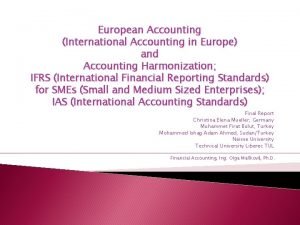ACCOUNTING PROCESS INTRODUCTION TO ACCOUNTING The American Institute














































- Slides: 46

ACCOUNTING PROCESS

INTRODUCTION TO ACCOUNTING The American Institute of Certified Public Accounts (AICPA) defined Accounting as “Accountancy is the art of recording classifying and summarizing in a significant manner and in terms of money transactions and events which are in part of at least a financial characters and interpreting the result there of”. Accounting may be defined as the process of recording, classifying, summarizing, analyzing and interpreting the financial transactions and communicating the results.

ACCOUNTING PRINCIPLES Accounting Concepts a) Business entity b) Going Concern c) Money Measurement d) Cost Concept e) Accounting period f) Duel aspect g) Accrual Concept h) Matching Cost i) Realization Accounting Conventions a) Disclosure b) Materiality c) Consistency d) Conservatism

BRANCHES OF ACCOUNTING Accounting has forms of branches as under : - Accountancy Financial Accounting Cost Accounting Management Accounting Tax Accounting

The Accounting Process 1) Identification of Transaction 2) Preparation of Documents 3) Recording of Transaction in Journal 4) Posting to ledger 5) Preparation of Trial Balance 6) Passing Adjusting Entries Profit & Loss A/C 7) Preparation of Final A/Cs Balance Sheet Fund Flow Statement Cash Flow Statement

ACCOUNTING SYSTEM Single Entry System Double Entry System Cash System Accrual system

Single Entry System • The single entry system appears to be time saving and economical but it is unscientific, having number of defects. • Under single Entry system only few personal accounts are kept, as nothings; Expenses / Income accounts are totally ignored. • This system is followed by sole proprietor, having total control on cash as well as on goods. • However this system is not generally followed by any trader.

Double Entry System • The Double entry system is based on scientific principle and is used universally by most of business organizations • Every business transaction involves exchange of equal values or benefits. • Exchange means the act of giving or receiving one thing in return of the other thing or service or benefit. Thus every transaction has two aspects i. e. receiving and giving. • The receiving aspect is also known as the incoming aspect (Debit) and going aspect is known as the outgoing aspect (credit). • Under double entry system books of accounts can be maintained by either cash basis or accrual basis.

Cash System of Accounting • Under cash system of accounting entries are made only when cash is received or paid. • No entry is made when amount is due for receipts or payments. • Income is received is accounted irrespective of period for which relates. • Similarly expenses are restricted to the actual payments made in cash, during the current period is immaterial whether the payments have been made for previous year or subsequent year. • This type of financial statement is suitable for very small business organization, for individual to record his own transaction, for professionals like doctors, lawyers, Chartered Accountant etc.

Accrual System of Accounts • This is also known as mercantile system of accounts. • Under this system business transactions are recorded as and when it take place irrespective of amount / cash received or paid. • Income earned as well as expenses incurred are recorded related to the Particular period. The following are the essential features of accrual basis. a) Revenue is recognized on it is earned, irrespective of whether cash is received or not. b) Costs are matched against revenues on the basis of relevant time period to determined periodic income. c) Costs which are not charged to income are carried forward. Any cost that lost its utility is written off as a loss.

Account • An account is summarized record or statement of all transactions relating to a particular person or to a Assets or liability or income or expense. • According to Koehler's Dictionary for accounts, An account has been defined as a formal record of a particular type of transaction expressed in money. _________ Account Dr. DATE PARTICULARS JF AMOUNT DATE PARTICULARS Cr. JF AMOUNT

Classification of Account Personal Accounts Impersonal Accounts Real Accounts Nominal Accounts Valuation Accounts

Personal Accounts • • These accounts show the transactions with customers, suppliers, Money lenders, the banks and the owner. For example: Aditya’s A/c, Chetan’s A/c, Mr. Hrishikesh and Co. Reliance Industries Ltd. , Apna Bazar Co-operative Society Ltd. , Mumbai University, Dena Bank etc. Real Accounts Real accounts may be the following types. 1. Tangible real Accounts: These are accounts of such things which are tangible i. e. which can be seen touched or felt physically. Example: Land, Building, Furniture, Cash etc. 2. Intangible real Accounts: These accounts represent such things which cannot be touched, seen or felt physically. Example: Goodwill, Trade marks, Patent right copy right etc.

Nominal Accounts includes accounts of all expenses, losses, incomes and gains. Nominal Accounts represent only services or uses. • • Valuation Accounts • Valuation accounts are accounts open to adjust values of assets e. g. provision for Depreciation, Stock Reserve, Provision for doubtful debt A/c.

Accounts Personal Account Relating to persons or Institutions. Examples: Akshay’s A/c, Soham’s A/c, Hitesh’s A/c, Bank A/c, University, School, Company Firm etc. Impersonal Account Real Account Nominal Account Relating to Assets or property Examples: Land & Building A/c, Cash A/c, Debtors A/c, Stock A/c, Goodwill A/c etc. Relating to expenses and Incomes. Examples: Salaries A/c, Rent A/c, Commission A/c, Discount A/c etc.

Rules Of Debit & Credit • The two sides of any account are arbitrarily distinguished. The left hand side of an Account is called Debit side and Right hand side is called the Credit side. • When entry on the left side is made it is called account is debited, and an Entry made on the right hand side of account is called account is credited. Golden Rules Of Debit & Credit A Personal A/c B Real A/c C Nominal A/c Debit the receiver, Credit the giver Debit what comes in, Credit what goes out Debit expenses or losses, Credit Income & gains

Personal Accounts • The personal Account which receives the benefit is debited, while the personal account which gives the benefit is credited. • The rule means, if a person receives anything from the business, his account will be debited in the books of business, and if person gives anything to the business, his account will be credited. Real Accounts • As a thing either comes in into business or goes out of business. • Real account relates to things or property. Hence the rule says if anything is coming into business, account of thing is to be debited anything is going out of business account of that thing is to be credited.

Nominal Accounts • Being the accounts of losses and expenses or gains and incomes. • The accounts of expenses or losses of the business are to be debited where as the accounts of Incomes or profits are to be credited Exp. Paid salaries. • Here Salary is on expenditure of the business and therefore Salary account is to be debited. • In the transaction “Received Interest from A & Co” Interest is an Income of the business and hence Interest Account is to be credited. Dr. Nominal Accounts Payment of Salary, rent loss on sale of Assets. Bad Debts etc. Received Commission. Interest Discount etc. Debit losses and expenses. Credit Incomes and Gains. Cr.

BOOKS OF ACCOUNTING JOURNAL LEDGER TRIAL BALANCE FINAL ACCOUNT

JOURNAL § It is essential in a business to record each and every transaction immediately after it takes place. § To record transaction a separate book called “Journal” is maintain. § To record non cash transactions like Credit Sales, Credit Purchases, Sales Returns, Purchase Returns. These Books are called Subsidiary books. § Journal can be defined as a subsidiary book in which all day-to-day monetary transactions of business are recorded first as and when they take place in chronological order (i. e. date wise), in debit and credit form and in a systematic manner. § Journal is also known as “Prime Entry” or “Original Entry” book. Because transactions are first entered in this book and then they are posted in the Ledger.

Layout of Journal Date Particulars Voucher LF No. Dr. Amt (Rs. ) Cr. Amt (Rs. )

LEDGER § It is principle book of accounts relating to a particular person or property or revenue or expenses are recorded in summarize form. § It contains all accounts i. e. set of accounts such as real, nominal and personal. § Main function is to sort out all items from journal.

Dr. Date Cr. Particulars J. F. Amount Date Particulars J. F. Amount

POSTING § Every transaction is first recorded in book of original entry and then it is posted in to ledger. § Posting is made on debit side account which is debited and also to credit side account which is credited. § Entry on debit side starts with ‘To’ whereas on credit side its starts with “by”. § Name of credit account is written on credit side and name of debit account is written on debit side.

BALANCE AND BALANCING ACCOUNTS § Each account in ledger may have same entries on debit side of account & credit side of accounts. § Difference in total both sides termed as “ Balance Of Accounting”. § Process of extracting balance and inserting it on lesser side of an account is called ‘Balancing’ or ‘Closing’ of accounts.

TYPES OF BALANCE § Debit - If the debit side of account is heavier then its credit side balance is debit balance. § Credit - If the credit side of account is heavier then its debit side, balance is credit balance.

TRIAL BALANCE • The fundament principle of double entry book keeping is that debit must be equal to credit. In other words, debit aspect of any transaction is always equal to its credit aspect. • A trial balance is a summary of all the ledger balances outstanding as on particular date. • List of debit balances and credit balances should be equal. It said that Trial balance is tallied. • When trial balance tallies it establishes the arithmetical accuracy of record. • It is a statement prepared before preparing the final accounts. • It is a link between books of account and final accounts i. e. the Trading & Profit & Loss A/c and Balance Sheet.

Types of Trial Balance Trial balances are of two types: 1. Gross Trial Balance • Gross Trial Balance is prepared by taking all ledger account debit total and credit total, instead of considering ledger balances, as on a particular date. 2. Net Trial Balance (concern with) • Net trial balance is list of debit & credit balance, taken from ledger accounts on particular date. • Normally, net trial balance is prepare, since it is transferred to final accounts and personal and real accounts balance are carried forward from current year to subsequent year.

Gross Trial Balance can be as under – Sr. No. Name of Account Total debit side (Rs. ) Total credit side (Rs. ) 1 Ketan‟s Capital 5, 000 76, 000 2 Opening Stock 10, 000 - 3 Purchases 2, 10, 000 2, 000 4 Sales 2, 000 3, 05, 000 5 Sales Return 18, 000 - 6 Expenses 27, 000 - 7 Customers 1, 20, 000 26, 000 8 Suppliers 12, 000 80, 000 9 Cash 6, 000 - 10 U. C. Bank 96, 000 17, 000 5, 06, 000

Net Trial Balance can be as under – Sr. No. Name of Account Total debit side (Rs. ) Total credit side (Rs. ) 12, 000 - - 1, 02, 000 2, 10, 000 - 1 Opening Stock 2 Capital 3 Purchases 4 Purchase Return - 6, 000 5 Sales - 3, 11, 000 6 Sales Return 4, 000 - 7 Expenses 28, 000 - 8 Plant & Machinery 1, 20, 000 - 9 Customers 80, 000 - 10 Suppliers - 62, 000 11 Cash 6, 000 - 12 Bank balance 21, 000 - 4, 81, 000

SOME IMPORTANT ITEMS AND THEIR BALANCES Drawings Debit Balance Investments Debit Balance Purchases Debit Balance Goodwill Debit Balance Expenses Debit Balance Cash Debit Balance Carriage Inwards Debit Balance Capital Credit Balance Carriage Outwards Debit Balance Incomes Credit Balance Loan Taken Credit Balance Interest Received Credit Balance Suppliers Credit Balance Return Outwards Credit Balance Stock (opening) Debit Balance Interest Paid Debit Balance Loan Given Debit Balance Assets Debit Balance Sales Return Debit Balance

Example

Pass Journal Entries with the following information also prepare Ledger and Trial Balance Date Particulars Amount Jan 1 P started business with cash 20000 Jan 3 He opened a current account in the bank 5000 Jan 7 Purchased goods on credit from shubham and discount of Rs 100 was given 4000 Jan 10 Paid to shubham in full settlement 3900 Jan 13 Machinery Purchase 2000 Jan 16 Goods sold to swati 3000 Jan 18 Amount Received from swati 1000 Jan 20 Salaries Paid 700 Jan 23 Rent Received 300 Jan 28 Goods Purchased from Shrikant 4000 Jan 31 Depreciation on Machinery 700

Journal: Date Particulars 2006 Jan 1 Cash A/c To Capital A/c (Being Pandu started business wit cash) Dr. 20000 Jan 3 Bank A/c To Cash A/c (Being amount paid into Bank) Dr. 5000 Jan 7 Purchase A/c Dr. To Shubham A/c (Being goods purchase from shubham) 3900 Jan 10 Shubham A/c To Cash A/c (Being amount paid to shubham who allowed discount) L. F. Debit Rs. Dr. 3900 Credit Rs. 20000 5000 3900

Date Particulars L. F. Debit Rs. Jan 13 Machinery A/c Dr. To Creditors A/c (Being purchase of machinery on credit) 2000 Jan 16 Swati A/c Dr. To Sales A/c (Being sales of goods to swati) 3000 Jan 18 Cash A/c Dr. To Swati (Being amount received from swati) 1000 Jan 20 Salaries A/c Dr. To Cash A/c (Being payment of salaries) 700 Jan 23 Cash A/c To Rent A/c (Being rent received) 300 Dr. Credit Rs. 2000 3000 1000 700 300

Date Particulars Jan 28 Purchas A/c Dr. To Shrikant A/c (Being goods purchased from Shrikant) Jan 31 Depreciation A/c To Machinery A/c (Being depreciation on machinery) Total L. F. Debit Rs. Dr. Credit Rs. 4000 100 44100

Ledger Accounts Cash Account Cr. Dr. Date 2006 Jan 18 Jan 23 Particulars To Capital A/c To Swati To Rent A/c J. F. Amount (Rs. ) 2006 20000 Jan 3 1000 Jan 10 300 Jan 13 Jan 20 Jan 31 21300 Feb 1 To Balance b/d Date 9700 Particulars By Bank A/c By Shubham By Machinery A/c By Salaries A/c By Balance c/d J. F. Amount (Rs. ) 5000 3900 2000 700 9700 21300

Bank Account Dr. Date Particulars 2006 Jan 3 To Cash A/c Feb 1 To Balance b/d J. F. Amount (Rs. ) Cr. Date 2006 5000 Jan 31 5000 Particulars J. F. Amount (Rs. ) By Balance c/d 5000 Purchases Account Cr. Dr. Date Particulars 2006 Jan 7 To Shubham Jan 28 To Shrikant J. F. Amount (Rs. ) Date 2006 3900 Jan 31 4000 7900 Particulars By Trading A/c J. Amount F. (Rs. ) 7900

Shubham’s Account Cr. Dr. Date Particulars J. F. Amount (Rs. ) 2006 Jan 10 To Cash A/c To Discount A/c Date 2006 3900 Jan 7 100 4000 Particulars J. Amount F. (Rs. ) By Purchas A/c 4000 Discount Received Account Cr. Dr. Date Particulars 2006 Jan 31 To Profit and Loss A/c J. F. Amount (Rs. ) Date 2006 100 Jan 10 100 Particulars By Shubham J. Amount F. (Rs. ) 100

Capital Account Cr. Dr. Date Particulars J. F. Amount (Rs. ) 2006 Jan 31 To Balance c/d Date Particulars J. Amount F. (Rs. ) 2006 20000 Jan 1 By Cash A/c 20000 Feb 1 By Balance b/d 20000 Machinery Account Cr. Dr. Date Particulars 2006 Jan 13 To Cash A/c J. F. Amount (Rs. ) 2000 Date 2006 Jan 31 Particulars By Depreciation A/c By Balance c/d J. Amount F. (Rs. ) 100 1900 2000

Swati’s Account Cr. Dr. Date Particulars J. F. Amount (Rs. ) 2006 Jan 16 To Sales A/c Feb 1 Date 2006 3000 Jan 18 Jan 31 3000 2000 To Balance b/d Particulars J. Amount F. (Rs. ) By Cash A/c By Balance c/d 1000 2000 3000 Salaries Account Cr. Dr. Date Particulars 2006 Jan 20 To Cash A/c J. F. Amount (Rs. ) Date 2006 700 Jan 31 700 Particulars By Profit and Loss A/c J. Amount F. (Rs. ) 700

Sales Account Cr. Dr. Date Particulars J. F. Amount (Rs. ) 2006 Jan 31 To Trading A/c Date 2006 3000 Jan 16 3000 Particulars J. Amount F. (Rs. ) By Swati 3000 Rent Account Cr. Dr. Date Particulars 2006 Jan 31 To Profit and Loss A/c J. F. Amount (Rs. ) Date 2006 300 Jan 23 300 Particulars By Cash A/c J. Amount F. (Rs. ) 300

Shrikant’s Account Cr. Dr. Date Particulars J. F. Amount (Rs. ) 2006 Jan 31 To Balance c/d Date 2006 4000 Jan 28 4000 Feb 1 Particulars By Purchase A/c By Balance b/d J. Amount F. (Rs. ) 4000 Depriciation Account Cr. Dr. Date Particulars 2006 Jan 31 To Machinery A/c J. F. Amount (Rs. ) Date 2006 100 Jan 31 100 Particulars By Profit and Loss A/c J. Amount F. (Rs. ) 100

Trial Balance as on 31 January 2006 Particulars Cash A/c Capital A/c Bank A/c Purchases A/c Machinery A/c Swati’s A/c Salaries A/c Sales A/c Rent A/c Depreciation A/c Srikant’s A/c Total L. F. Debit (Rs) Credit (Rs) 9, 700 5, 000 7, 900 20, 000 - 1, 900 2, 000 700 100 - 3, 000 300 4, 000 27, 300

Notes : 1. The trial balance, prepared as above contains the list of all ledger accounts except Shubham’s account which is closed and does not show any balance (the totals of the debit and credit of Shubham’s account are equal). 2. Cash account, bank account, purchases account, machinery account, Swati’s account, salaries account, depreciation account, and interest on capital account show debit balance (excess of debit over credit). Hence, the balance has been shown in the debit column. In the same way, capital account, discount account, sales account, rent account, and Srikant’s account show credit balance, so the amount has been written in the credit column. 3. The total of the debit and credit side each is Rs. 27, 400 and is equal.

Thank You
 American sailing institute
American sailing institute American crime prevention institute
American crime prevention institute Aiche code of ethics
Aiche code of ethics American institute for cognitive therapy
American institute for cognitive therapy Aip style
Aip style American student achievement institute
American student achievement institute Mock osha inspections
Mock osha inspections Gpsmap 547
Gpsmap 547 Creative commons license
Creative commons license American student achievement institute
American student achievement institute American segmental bridge institute
American segmental bridge institute American language institute csulb
American language institute csulb Hình ảnh bộ gõ cơ thể búng tay
Hình ảnh bộ gõ cơ thể búng tay Bổ thể
Bổ thể Tỉ lệ cơ thể trẻ em
Tỉ lệ cơ thể trẻ em Chó sói
Chó sói Thang điểm glasgow
Thang điểm glasgow Chúa yêu trần thế
Chúa yêu trần thế Các môn thể thao bắt đầu bằng từ đua
Các môn thể thao bắt đầu bằng từ đua Thế nào là hệ số cao nhất
Thế nào là hệ số cao nhất Các châu lục và đại dương trên thế giới
Các châu lục và đại dương trên thế giới Công thức tính thế năng
Công thức tính thế năng Trời xanh đây là của chúng ta thể thơ
Trời xanh đây là của chúng ta thể thơ Cách giải mật thư tọa độ
Cách giải mật thư tọa độ 101012 bằng
101012 bằng Phản ứng thế ankan
Phản ứng thế ankan Các châu lục và đại dương trên thế giới
Các châu lục và đại dương trên thế giới Thể thơ truyền thống
Thể thơ truyền thống Quá trình desamine hóa có thể tạo ra
Quá trình desamine hóa có thể tạo ra Một số thể thơ truyền thống
Một số thể thơ truyền thống Cái miệng nó xinh thế chỉ nói điều hay thôi
Cái miệng nó xinh thế chỉ nói điều hay thôi Vẽ hình chiếu vuông góc của vật thể sau
Vẽ hình chiếu vuông góc của vật thể sau Nguyên nhân của sự mỏi cơ sinh 8
Nguyên nhân của sự mỏi cơ sinh 8 đặc điểm cơ thể của người tối cổ
đặc điểm cơ thể của người tối cổ Thế nào là giọng cùng tên
Thế nào là giọng cùng tên Vẽ hình chiếu đứng bằng cạnh của vật thể
Vẽ hình chiếu đứng bằng cạnh của vật thể Vẽ hình chiếu vuông góc của vật thể sau
Vẽ hình chiếu vuông góc của vật thể sau Thẻ vin
Thẻ vin đại từ thay thế
đại từ thay thế điện thế nghỉ
điện thế nghỉ Tư thế ngồi viết
Tư thế ngồi viết Diễn thế sinh thái là
Diễn thế sinh thái là Dot
Dot Số nguyên là gì
Số nguyên là gì Tư thế ngồi viết
Tư thế ngồi viết Lời thề hippocrates
Lời thề hippocrates
